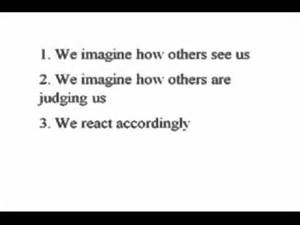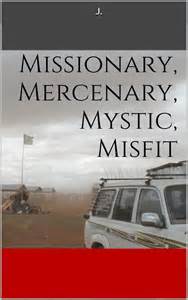The moral career of a humanitarian aid worker
Sit back. This one may take a while.
The goal of this post is to meaningfully apply the concepts of ‘moral career’ and ‘looking-glass self’ to better understand the lives of aid workers as they move through their professional lives. In this post I want to emphasize the overall journey of a career as opposed to a snapshot of single moment. This will make it possible to consider the evolution of self identity that occurs over the course of an aid worker’s career.
Moral career and self identity
I borrow the phrase ‘moral career’ from sociologist Erving Goffman. His classic book Asylums was published in 1961 as a “collection of essays on the social situation of mental patients and other inmates”. Goffman defines moral career as “…any social strand of any person’s course through life…the regular sequence of changes that career entails in the person’s self and in his imagery for judging himself and others.” He continues by explaining that,
“The moral career of a person of a given social category involves a standard sequence of changes on his way of conceiving of selves, including importantly, his own….Each moral career, and behind this, each self, occurs within the confines of an institutional system…and can be seen as something that resides in the arrangements prevailing in a social system for its members.”
Finally he concludes that, “This special kind on institutional arrangement does not so much support the self as constitute it.” (Asylums, 1961: 168)
Here Goffman brilliantly foreshadows the groundbreaking works of first Stanley Milgram (author of Obedience to Authority and then, later by Phillip G. Zimbardo (famous for the Stanford prison experiment and The Lucifer Effect). Both researchers stress the “institutional arrangement” and its impact on behavior and, hence, sense of self as one reflects on their behavior. And, not inconsequentially, their free will as well.
Is it possible that in most instances instead of thinking and then deciding to act, we act and then explain our actions to ourselves and then to others? Questions of this nature are challenging, to be sure, but important to consider.
There are two main points to keep in mind as we move forward. First, the idea that we all go through stages in various parts of our lives is now fairly standard social science fare, perhaps made most famous by Elizabeth Kübler-Ross’ book On Death and Dying. Her detailing the five stages of coming to grips with death remains a useful tool for many. This post will serve to extend the idea of stages to include the lives of aid workers. The second point is harder to grasp because it is counterintuitive, namely that our sense of self is, in many ways, outside of our control.
Looking-Glass Self
Social psychologist George H. Cooley is generally credited with the term ‘looking-glass self.’ One’s  sense of self is, to a certain extent, a product of how we imagine others to see us -both physically and our behaviors-, and how we imagine how others evaluate what they see.
sense of self is, to a certain extent, a product of how we imagine others to see us -both physically and our behaviors-, and how we imagine how others evaluate what they see.
Humanitarians all know intuitively how beneficiaries will see them when driving up in a white land cruiser or, alternately, on public transport.
To merge another of Goffman’s ideas with Cooley for a moment, we all manage our identity by manipulating how we are seen by others. What both Cooley and Goffman are saying is, simply, that our identity is in flux and depends upon social context to a good extent. For aid workers, the ‘social context’ one finds themselves in can be a challenge and is something that is thrust upon them more frequently than it is chosen.
That said, we can put everyone on a continuum with two end points. On one extreme there are people who’s sense of self are totally driven by how they see others seeing them. We’ll call these chameleon-like people ‘other directed’. On the other extreme are those who are totally unwavering in their self concept and are driven, as it were, by an internal gyroscope. We’ll call these people ‘inner directed.’ The two ends of the continuum are, of course ideal types and only exist as points of reference.
Key to note is that where one is on the above continuum is in flux most of the time and depends on many factors, perhaps most importantly (1) the age and maturity of the person and (2) the social context in which the person finds himself/herself. Very young people are always reading social cues from others and, in general, are very other directed: if an authority figure tells a young person they are stupid they tend to believe it. All of us, in various social situations, look for cues to see how we are fitting into our social surroundings with appropriate cultural sensitivity.
The remainder of this post will focus on using Goffman’s term ‘moral career’ to better understand the lives of aid workers and to suggest that they too have a moral career.
A fitting, fictional example
Perhaps the most prominent example of fiction writing about the lives of aid workers is the series of books by J. Here Mary-Anne and Jon Langstrom speak to us from Missionary, Mercenary, Mystic, Misfit:
“Somewhere I read—can’t remember where, exactly. Anyway, it was a description of aid workers as missionaries, mercenaries, mystics, and misfits. And the longer I stick around, the more I see it.” Jon looked around for the waiter, and then motioned for two more bottles of St. George. Mary-Anne could already tell that she’d probably miss curfew. Again.
 “The problem is that when people use that phrase, they’re usually describing where we’ve come from. They mean it’s what we were before we accidentally found our way into humanitarian work. But I think they’re wrong. I think it’s about what we become. It’s a description of states of being toward which humanitarians gravitate.”
“The problem is that when people use that phrase, they’re usually describing where we’ve come from. They mean it’s what we were before we accidentally found our way into humanitarian work. But I think they’re wrong. I think it’s about what we become. It’s a description of states of being toward which humanitarians gravitate.”
Mary-Anne was suddenly on the edge of her chair, hanging on every word.
Jon Langstrom’s tone was matter-of-fact. “We all start out with these altruistic intentions. We’re going to save the world, or at least a little corner of it. We’re going to do everything properly, we’re on the ‘right’ side of all the issues all the time. We’re self-styled warriors for truth and light. That’s the ‘missionaries’ part.”
Two more bottles of St. George appeared and Jon held one out to her. Mary-Anne took it although somewhere in the back of her head she knew she’d probably regret doing so. But for now she was in the mood to drink a bit more and listen to Jon Langstrom bequeath his wisdom. She took a sip and said, “Go on.””
Jon took a sip himself and nodded.
“So, we’re all on the side of right and light, warriors for the poor, and all of that. Then we get into it a little way and we see that it works by calculus, not math. We see what goes into the sausage. We see that for all of our dialogic, participatory, multi-stakeholder, community-led, bottom-up, embrace-and-empower-everything-local ideals and maybe even practice, that the decisions that truly matter are made elsewhere and on the basis of other things entirely. We come to understand that we have to play hardball. If we stick around long enough, we usually get to the place where we’re willing to fight for a program or strategy we think is the best one, even when it means throwing a colleague under the bus. There are times and places in this industry where, for all of our professed love of all humanity, a win-win is just not possible. We choose this poor community rather than that one because the donor wants this one, not because the needs are greater. We sacrifice little bits of who we are and what we believe in the service of some alleged bigger picture. Then the little bits get bigger. We become extreme. We’re willing to execute more tactical bad in the name of an increasingly elusive and vague strategic ‘greater good.’ For some, it becomes an ‘ends justify means’ thing. But one way or the other, we become mercenary.”
He exhaled sharply. It was almost totally dark in the courtyard at Billy-Bob’s now. Without waiting for a response from Mary-Anne, Jon continued.
“That altruism, or what we took as altruism that drove us to this line of work isn’t a bad thing. We want the world to be better. We can envision a more just or a less unjust world. Some of us become hyper cause-oriented. We delve into the theory or maybe the technical nuts and bolts of practice in a particular sector. And in that sense some of us become mystics.”
“But as in everything else, there are trade-offs. There is always the danger of spending so long immersed in the language and culture of humanitarian aid that anything outside feels incomprehensible. We spend so long focused on a particular way of thinking about issues, like reproductive health or third world hunger, that we lose our ability to engage with those who see the issues differently. Or, and this is the even greater danger, we lose the ability to really engage with those who simply haven’t thought about them at all: the ordinary people in our families and social circles.”
“It’s a paradox, but we can spend so long out here that we begin to treat home like we treat ‘the field.’ Which is to say that we become perpetual temporary interlopers who embrace our ‘not from here’ status as an excuse to see everything clinically and still always have a way out. Our visa is about to expire and we have to go home or to the next mission. Or we have another mission and have to leave home…”
Jon stopped mid-sentence and paused, as if weighing his words.
“We become misfits.”
J does several things with this dialogue. First, he acknowledges that the alliterative phrase “missionary, mercenary, mystic and misfit” is an oft used trope, but he immediately distances himself from the traditional two-dimensional use of these words as mere labels for static categories. An example of this is the otherwise insightful article published in 2006 by UK researcher R.L. Strait entitled “Mercenaries, Missionaries, and Misfits: Representations of Development Personnel” . J’s character, Jon Langstom, is quick to note that these four stages -missionary, mercenary, mystic and misfit- are “states of being” and points along a journey; he anticipates the utility of the moral career concept.
But what exactly is this utility? Let me be clear in pointing out that neither J nor I are selling any version of the truth, but rather doing what comes naturally to those who seek to understand, namely describe and categorize and then offer, tentative as it may be, analysis and explanation. In the words of Miguel de Unamuno,
“My intent has been, is, and will continue to be, that those who read my works shall think and meditate upon fundamental problems, and has never been to hand them completed thoughts. I have always sought to agitate and, even better, to stimulate, rather than to instruct. Neither do I sell bread, nor is it bread, but yeast or ferment.” (Perplexities and Paradoxes New York: Greenwood Press, 1968:8)
That is to say, any conceptutal framework that one imposes on social reality can be usefully judged by the kinds of questions it generates. Since this blog [book] intends to report on data gathered rather than spin out deep analysis, I will not go into answers to some of the questions below, but perhaps simply suggest them as useful points of departure.
So, what questions do emerge as we think about the “moral career of the aid worker?”
- Can further describing these stages be of therapeutic value to an individual aid worker as she attempts to examine her career?
- Are human resource personnel responsive to and aware of these stages?
- When mental illness becomes an issue, how does this impact these stages?
- Are these stages different/progress through these stages different for relief/aid versus development workers?
- How do life-partners help or hinder awareness of stages?
- How does this play into the concept of compartmentalization (e.g., ‘deployment smoker’)?
- To what extent are these four stages exhaustive? Are there stages that are missed, jumped over or just ignored? If so, what are they?
- What kinds of events or experiences move a person from one stage to the next?
- How long does one stay in each stage? Is is possible to get permanently “stalled” in one of the early stages?
- Can you regress through the stages and/or can there be a cycling through?
- How do you communicate with someone in another stage? How is social networking helping or hindering progress through stages?
- After misfit….what is there? Does one ever fit back into her ‘home’ world?
- Finally, how do you know who you really are? As Berger pointed out, we are all reinterpreting our past. How do we know our present self is fully formed? How can you know your motivations are true to who you are? When are you you and when are you just playing the role into which the social situation places you?
Yes, the above list does drill down to the existential core. Too deep for some, but valid nonetheless since considering these questions might serve as a useful backdrop for more deeply understanding the data. Asking these detailed questions allows us to better understand the reality of the aid workers experience and it allows us to better represent aid worker voices.
For example, my post “You are as you are seen: race/ethnicity/identity” includes numerous touching and thoughtful statements from aid workers as they reflected on their identity and, in retrospect, on their journey though some stages. Other posts [chapters] include similar points of departure for our understanding. Take a look at this post “The impact of gender on the lives of aid workers” regarding the impact of gender on identity.
I’ll end here with a nod back to Goffman. He argues that only by understanding both one’s structural context and the internal dialogue that takes place can we fully understand not only our own identities but as well the identities of those around us.1 I agree.
As always, feel free to contact me with your thoughts, feedback or snarky comments.
1A contemporary of Goffman, C. Wright Mills tells us the same message,“Neither the life of an individual nor the history of a society can be understood without understanding both.”


 Follow
Follow